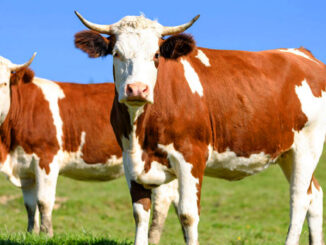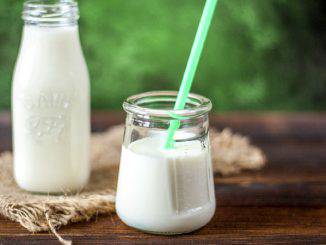
Our readers often complain that their Kefir isn’t getting as thick as they expect. How thick should be a decently fermented Kefir, they ask? Why is my Kefir still watery after 12 hours or more of fermentation? How to make Kefir as thick as yogurt? Is the density of Kefir a criterion for a good level of fermentation?
So, let’s dig deeper into all aspects of Kefir’s thickness (or density) and try to answer these questions.
What determines the density of Kefir?
The “thickness” of Kefir primarily depends on the content of fats in the milk and the water content (moisture level) of the fermented brew.
So, if you want to obtain a thicker and creamy Kefir, you should either use milk with the highest possible content of fats (preferably full-fat milk) and/or remove the excess of moisture from Kefir by additionally draining it out through a cheesecloth.
Sometimes the density of Kefir can be improved by also adding cream before the fermentation of Kefir, which would additionally increase the fat contents of milk.
On the other hand, it is important to stress that there is no correlation between the probiotic powers of Kefir and its density.
A thicker and creamier Kefir is in no way richer in probiotics than a thinner one, neither is a thinner Kefir a less powerful probiotic than a thicker one.
In other words, the density of Kefir doesn’t have anything to do with its probiotic virtues. A thinner and “watery” Kefir may be as rich in probiotics as a thicker and creamier Kefir.
What’s considered a “normal” density of Kefir?
Many newbies in Kefir making are expecting to get a Kefir similar in density to yogurt and even as thick as Greek yogurt. To their disappointment, this can be rarely achieved, not only because yogurt is by default thicker than Kefir, but also because Greek yogurt is obtained through additionally removing the moisture (draining out the whey) from normal yogurt.
Depending on the fat contents of milk, the density of Kefir considered as “normal” may range from the thickness of a diluted yogurt down to the density of natural non-fermented milk if low-fat or skimmed milk is used.
Of course, the thickness of Kefir increases with the time of fermentation. The longer Kefir ferments, the thicker it gets. However, after a certain level of fermentation, Kefir will start to either separate, become too sour, or both. So, extending the primary fermentation may not be regarded as a reliable way to increase Kefir’s density and creaminess.
A reliable sign of a completed fermentation of Kefir is not its thickness, but its taste and its first signs of separation. Your Kefir is fully fermented and ready for the second ferment when little pockets of whey are visible through the walls of the jar. Once they appear, any further fermentation will not make your Kefir thicker but instead will only make it sourer and tangier.
Let’s summarize at this stage:
- The “normal” density of Kefir is similar to diluted yogurt and obtaining a Kefir thicker than that requires additional techniques.
- There is no correlation between the probiotic powers of Kefir and its density. A thicker Kefir is not necessarily richer in nutritional or probiotic powers.
Still, if you insist on obtaining a denser and creamier Kefir, there are several ways to do this.
How to obtain a thicker and creamier Kefir?
Use full-fat (whole) milk
Since the fat content of milk is the main contributing factor to Kefir’s density, the most reliable and natural way to get a creamier Kefir is to use full-fat milk.
The addition of cream before fermentation will also increase the thickness of the resulting Kefir, but yet, mind your cholesterol levels. Furthermore, the presence of cream could increase the tendency of Kefir to separate so, closely monitor your Kefir at its later stages of fermentation. The use of low-fat or skimmed milk will inevitably lead to a thinner and “runny” Kefir.
For a thicker Kefir, try to use kinds of milk that contain more fats. For instance, sheep’s milk usually contains more fat than cow’s milk, while goat’s milk contains less. Everyday practice shows that cow’s milk is best suited for the needs of the Kefir grains because of its overall structure in terms of fats, proteins, and minerals content. So, cow’s whole milk appears to be the best choice when looking for a thicker Kefir.
However, regardless of the suggestions, you may find on some websites, do not be tempted to use raw (unpasteurized) milk. Although unpasteurized milk may indeed give better results in Kefir thickness, it may contain harmful bacteria which will remain dangerous even after Kefir’s fermentation.
Add cream
As we said earlier, adding a certain percentage of cream to the milk will increase its content of fats which will inevitably lead to a thicker and creamier Kefir.
This percentage may be anywhere between 10% and 50%, depending on your personal taste and goals. Remember though that the fats don’t get anyhow converted during fermentation and they remain fats, with all their converse effects on cholesterol levels, blood sugar, etc.
Ferment Kefir at lower temperatures (in the fridge)
Many Kefir addicts have found that during winters their Kefir is getting thicker than in the summers. This fact has its scientific explanation.
As we know, Kefir contains two types of probiotic microorganisms: bacteria and yeasts, and mainly bacteria are the ones responsible for the thickening of Kefir.
Since low temperatures act in favor of the development of bacteria (at the expense of the yeasts), Kefir that has fermented at low temperatures is usually thicker than the one fermented at higher temperatures. Therefore, if you let your Kefir ferment in the fridge, the fermentation will take considerably longer, but the resulting Kefir brew will be denser and creamier.
The bad news here is that fermentation at low temperatures may really take longer – sometimes several days or even a week. A possible remedy for that issue is to increase the number of Kefir grains for the same quantity of milk. In this way, the fermentation slow-down caused by low temperatures may be partially compensated.
Add lemon peels
Adding dried or fresh finely ground lemon peels to your Kefir during the second fermentation can improve both Kefir thickness and taste (if you like lemon’s aroma, of course). The lemon peels nicely react with the milk and act as a natural thickener to Kefir.
Last resort: add artificial thickeners
And yes, really as a last resort, and if nothing else works, you can always use artificial thickeners.
Adding stuff like gelatin, corn starch, or agar-agar to your Kefir will inevitably make it thicker. Don’t forget though, that they can interfere with the final taste of Kefir and sometimes make it … well … kind of weird.
Still, if you desperately need your Kefir to look like Greek yogurt, you will always have the possibility to achieve it.



